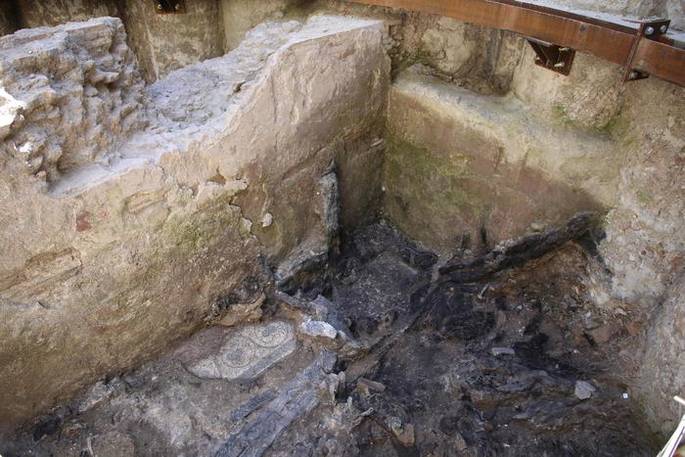


Excavations to extend the Metro Line C in Italy’s capital once again resulted in Roman archeological finds. Following the discovery of military barracks last year, which may have been used by the Praetorian Guard [2] under Emperor Hadrian [3], the charred ruins of two early 3rd century buildings and the 1,800-year-old skeleton of a crouching dog were recently uncovered.
Archeologists shared on Monday that they discovered the ancient solarium on May 23 while examining a 33-foot-deep hole bored near the city’s Aurelian Walls [4] as part of work for the new public transport line.
According to experts, the two spaces found from the dig date to the mid-imperial period of the Roman Empire and might be from either an aristocrat's home at the foot of the nearby Caelian Hill [5] or from the aforementioned military barracks. Either way, the finds offer clues to how Romans lived and built at the time.
The unearthed ruins feature well-conserved parts of a wooden ceiling and furniture, including a leg of a stool or table; another one, possibly from a wooden trunk; a small table; a larger table; a wooden railing or handrail; frescoed wall fragments with a reddish hue; and black-and-white mosaic floor tiles on the upper floor of the collapsed building.
The dog's remains included part of a jaw with intact teeth and were found at the door of the house, indicating that the animal was trapped in the building.
"Mini Pompeii" in Rome
The culture ministry described the findings as a “Pompeii-like scene,” evoking comparisons to the inhabitants trapped by the eruption of Vesuvius in 79 A.D. [6] and preserved for centuries in volcanic ash. In this case, the solarium and adjacent structures were in excellent shape thanks to an onsite fire. "The material is only conserved in exceptional environmental and climatic conditions, or after special events like those that took place at Herculaneum and Pompeii.” Sources at the ministry continued, "For the moment, the discovery of a charred, wooden ceiling represents a unique event for the city of Rome.”
Francesco Prosperetti [7], in charge of Rome's archaeological ruins and excavations, shared, "The fire that stopped life in this environment allows us to imagine life in a precise moment.”
The Future of the Remains, Metro
When asked if the remains would be displayed in the future Amba Aradam-Ipponio [8] metro station, like the army barracks will be, an archaeologist explained that it’s too early to say for sure.
"The placement [of the remains] must still be studied," she said. "But we believe that all this must have a placement that is worthy of it.”
The ongoing excavation is taking place on the southern slopes of the Caelian Hill.
The stretch of the metro from Amba Aradam to the Imperial Fora is scheduled to be unveiled in 2021.
Source URL: http://test.casaitaliananyu.org/magazine/focus/art-culture/article/pompeii-scene-found-in-rome-metro-dig
Links
[1] http://test.casaitaliananyu.org/files/ruinsjpg
[2] http://www.ancient.eu/Praetorian_Guard/
[3] http://www.ancient.eu/hadrian/
[4] http://www.aviewoncities.com/rome/aurelianwall.htm
[5] http://romereborn.frischerconsulting.com/ge/GF-004.html
[6] https://ttps://en.wikipedia.org/wiki/Eruption_of_Mount_Vesuvius_in_79
[7] http://archeoroma.beniculturali.it/prosperetti
[8] https://en.wikipedia.org/wiki/Amba_Aradam-Ipponio_(Rome_Metro)